Author Archive
NAA Algae Production Workshop
Robert Henrikson, Smart Microfarms, presented “Opportunities in Scalable Algae Microfarms: emerging production, supply chains, products and marketing” at the National Algae Association “Algae Production Networking Workshop” on April 23, 2015 in Richmond California. Collaboration + Innovation = Fast-track Commercialization of the Algae Production Industry.

Continue Reading | Comments Off on NAA Algae Production Workshop
Spirulina Viva Mexico
In January, Robert Henrikson visited San Miguel de Allende, Mexico, and just outside of town, the first spirulina algae microfarm in Mexico – Spirulina Viva. Here Katie and Paco and their sons Kai and Teo live by their greenhouse farm, producing fresh, frozen and dried spirulina and delicious spirulina snacks. They sell direct to local customers and to retail shops in San Miguel and ship product all over Mexico. Check out www.spirulinaviva.com.

Spirulina Viva founders Katie and Paco with son Teo, meeting with Robert at the greenhouse.

Spirulina Viva’s 300 m2 greenhouse outside of San Miguel de Allende, Mexico.

Spirulina Viva fresh spirulina, Teo with green face, spirulina treats.
Continue Reading | Comments Off on Spirulina Viva Mexico
Apulia Kundi Spirulina Programme
The spirulina “Green Business – Alimenta L’Impresa” programme was presented by Robert Henrikson in Bari, southern Italy, December 3,4,5, 2014 at the agricultural technology institute Laboratori dal Basso, sponsored by Agenzia Regionale per la Technologia e L’innovazione. Streaming video and simultaneous translation attracted a large online audience.
The association Apulia Kundi won a grant in 2012 sponsored by the region of Puglia and set up a spirulina microfarm at a greenhouse on Bari University campus. The team members of Apulia Kundi have been growing, harvesting and transforming spirulina into local foods like the green tagliatella below. This is the first spirulina farm in southern Italy. The next step is to set up a larger commercial spirulina farm.

Apulia Kundi classroom, team, spirulina microfarm and fresh tagliatella pasta with spirulina.

Continue Reading | Comments Off on Apulia Kundi Spirulina Programme
Bioneers Summit Conference
Smart Microfarms demonstrated a modular spirulina algae growing system, a new model of the future of farming at the Change Makers Fair at the 25th Annual Bioneers Summit Conference held October 17,18,19, 2014 in San Rafael California. Bioneers – Revolution from the heart of nature.

Serving shots of fresh frozen spirulina in apple, orange and peach juices.

Continue Reading | Comments Off on Bioneers Summit Conference
NAA Workshop for Algaepreneurs
Robert Henrikson, Smart Microfarms, presented “Evolution of Scalable Algae Production and New Business Opportunities” at the National Algae Association “Commercial Algae Cultivation, Harvesting, Extraction Technologies and Networking Workshop” on February 28, 2014 in Richmond California. NAA is the “Home of the Algaepreneur”.

Continue Reading | Comments Off on NAA Workshop for Algaepreneurs
The Future of Urban Farming?
Are Algae Microfarms the Future of Urban Farming?
Growing local food in community gardens and urban farms is a popular and growing trend. Because urban space is limited and valuable, some entrepreneurs are transforming old warehouses and even underground spaces into indoor farms using artificial lighting. Others propose vertical farms, even growing food in skyscrapers.
But some scientists calculate that indoor urban farming results in food production with a high cost, high energy use and a big carbon footprint, regardless of whether energy comes from the conventional grid or renewables. They caution indoor food grown with artificial lighting may be less sustainable and more damaging to the environment than food transported from 3000 miles away.
Greenhouses growing food in empty lots or nearby urban areas would be a more cost effective solution. Urban greenhouses would extend the growing season, use existing urban infrastructure, enjoy close access to local markets and customers, and harness the best source of energy – the sun.

Will algae microfarms grow new superfoods for urban and rooftop farms around the world?
What’s coming now is the opportunity to grow high value microalgae to diversify greenhouse food production and significantly enhance revenues.
Over the past 30 years the microalgae spirulina has gained global recognition as a superfood supplement. This productivity breakthrough grows over 20 times more protein than any other conventional food crop on the same area, yet its therapeutic benefits are even more remarkable. Published international research shows how small amounts daily boost immune function, enhance detoxification, restore beneficial intestinal flora, improve neurological function and rally the body’s own healing response. Spirulina commands premium retail prices, $80/lb for dry product in the USA, €150/kg in France. Where fresh frozen product is available locally, even higher prices.
Most people think of large algae farms located in hot sunny desert or tropical locations. But in this past decade, over 110 algae greenhouse microfarms have spread across France. In the USA, spirulina is being successfully grown in greenhouse microfarms in the northern climate of the Pacific Northwest.
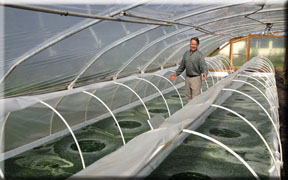
< Algae growing ponds have retractable and removable greenhouse covers. In cooler seasons, ponds are covered at night to retain warmth. In summertime, covers are completely removed.
These new algae microfarms are modular and scalable greenhouse systems with smart monitoring systems and web cameras so remote experts can successfully guide local operations at many locations simultaneously. With insulated ponds and efficient LED lighting and heating systems, the algae growing season can be extended in northern climates well beyond the typical short 4 or 5 months.
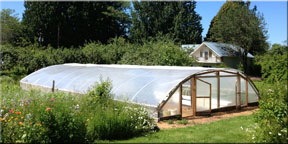
< The first Pacific Northwest spirulina microfarm near Olympia Washington. This eco-region has a temperate rainforest climate with warm sunny summers and wet cloudy cool winters.
Smart Microfarms’ CEO Robert Henrikson founded one of the world’s first and largest algae farms, Earthrise Spirulina in Southern California, 35 years ago. He explains his own evolution from large to small farms. “For decades, algae have been grown on large commercial farms with extensive technical staffing and infrastructure. Now the time has come to introduce algae microfarms to grow healthy foods in local communities. Profitable business models already exist.”
The Pacific Northwest algae microfarm testbed will develop metrics for microfarm operations and productivity especially for temperate climates. They will test practical, affordable and replicable systems for growing algae for local food and high value products in community, urban, rooftop, mobile and vertical gardens to demonstrate how microfarms can transform small food growing area into generating more income.
Smart Microfarms can help terrestrial, hydroponic and aquaponic greenhouse farms diversify income stream with high-value algae food products.
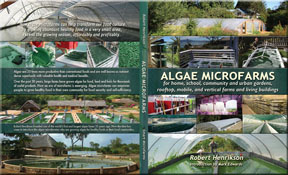
“Algae Microfarms”, the new book by Henrikson, available at Amazon.com, features individuals and organizations around the world growing algae on a small scale and making a difference today.
Some of these small farms are humanitarian, some are commercial, some are both. The book is a look into our future of scalable microalgae systems for home and community gardens, urban and rooftop farms and even living buildings.
Spirulina Algae Microfarm near Olympia Washington.
The first Pacific Northwest spirulina microfarm is located near Olympia Washington, a temperate rainforest eco-region with warm sunny summers and wet cloudy winters. Algae are harvested through a micro screen several times a week during the growing season. This smart microfarm testbed will show how algae microfarms generate income from a small area.
2:00 minute video of Spirulina Algae Microfarm near Olympia Washington (2013).
Continue Reading | Comments Off on The Future of Urban Farming?
Visit to Myanmar Spirulina
Visit to Myanmar Spirulina, December 19-23, 2013. June Pharmaceuticals is one of the world’s largest producers of spirulina from both natural lakes and production ponds. The company produces about 200 tons of spirulina per year and offers a variety of healthy innovative products including supplements, extracts, cosmetics, herbal products, biofertilizer and spirulina beer. See slideshow Myanmar Spirulina.
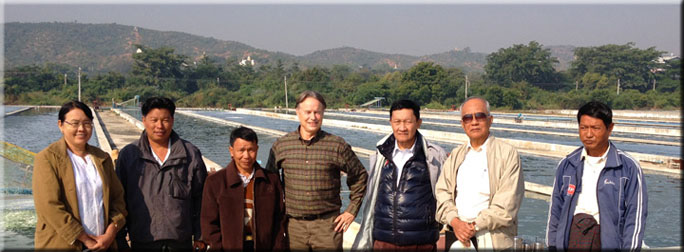
At June Pharmaceutical Industry Ltd Spirulina Production Farm and Factory in Sagaing. Founder and Director Dr. Min Thein, along with Robert Henrikson and management. December 20, 2013.
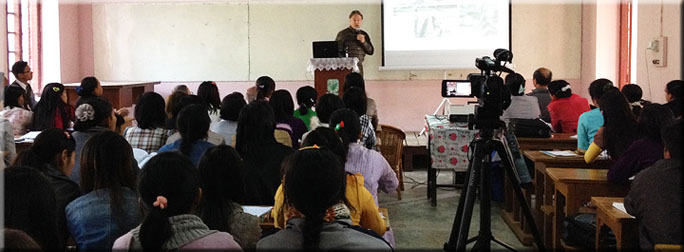
Robert Henrikson presents at University of Mandalay “Evolution of Scalable Algae Production and New Business Models”. December 20, 2013.
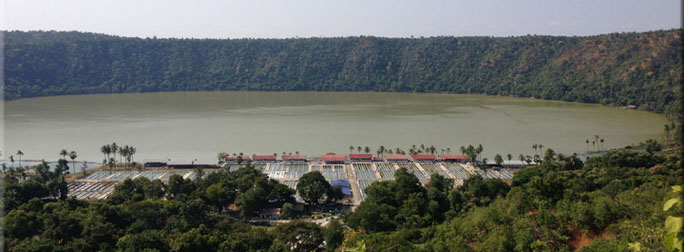 Natural spirulina lake Twyn Taung with spirulina pond production facility. December 21, 2013.
Natural spirulina lake Twyn Taung with spirulina pond production facility. December 21, 2013.
Continue Reading | Comments Off on Visit to Myanmar Spirulina
Microfarms for Rooftop and Urban Farms
Algae farms are often located in hot sunny desert or tropical locations, but new spirulina algae microfarms in the Pacific Northwest are testing features for growing algae in more northern temperate climates.

< Algae growing ponds have retractable and removable greenhouse covers. In cooler seasons, ponds are covered at night to retain warmth. In summertime, covers are completely removed.
Growing local vegetables in gardens and rooftop farms in urban areas around the world is a popular trend. Many urban farms use greenhouses with hydroponic and aquaponic systems to extend the natural growing season. Now high value microalgae, like spirulina, can diversify greenhouse food production and enhance revenues.

Will algae microfarms become new food crops for rooftop farms in cities around the world?
Over 30 years spirulina algae has gained global recognition as a superfood supplement. Published international research shows how consuming small amounts boost immune function, enhance detoxification, restore beneficial intestinal flora, improve neurological function and rally the body’s own healing response. For these reasons spirulina commands premium prices.

< The first Pacific Northwest spirulina microfarm near Olympia Washington. This eco-region has a temperate rainforest climate with warm sunny summers and wet cloudy cool winters.
These new algae microfarms are modular and scalable greenhouse systems with smart monitoring systems and web cameras so remote experts can successfully guide local operations at many locations simultaneously. With insulated ponds and efficient LED lighting and heating systems, the algae growing season can be extended in northern climates well beyond the typical short 4 or 5 months.
Smart Microfarms’ CEO Robert Henrikson founded one of the world’s first and largest algae farms, Earthrise Spirulina in Southern California, 35 years ago. He explains his own evolution from large to small farms. “For decades, algae have been grown on large commercial farms with extensive technical staffing and infrastructure. Now the time has come to introduce algae microfarms to grow healthy foods in local communities. Algae microfarms are simplified and affordable systems with lower cost of entry, and can be enhanced by automation and web-based monitoring systems to reduce the need for experts on site. Profitable business models already exist.”
The Pacific Northwest algae microfarm testbeds will develop metrics for microfarm operations and productivity especially for temperate climates. They will test practical, affordable and replicable systems for growing algae for local food and high value products in community, urban, rooftop, mobile and vertical gardens to demonstrate how microfarms can transform any small food growing area into higher income generating food products.
Smart Microfarms can help terrestrial, hydroponic and aquaponic greenhouse farms diversify income stream with high-value algae food products.
Continue Reading | Comments Off on Microfarms for Rooftop and Urban Farms
Olympia Smart Microfarm Opens
The Smart Microfarm Testbed was officially open on July 20, 2013. Visitors arrived from Seattle, Bellingham and British Columbia to tour the facilities and learn about this northern most spirulina microfarm near Olympia WA.

Continue Reading | Comments Off on Olympia Smart Microfarm Opens
Algae Microfarm & Aquaponics Workshop
Algae and aquaponics experts Robert Henrikson, CEO, Smart Microfarms; Henning Gatz, President, Aquacare Environment; and Mark Buehrer, director of 2020 ENGINEERING discuss algae microfarms & aquaponics and how to get these facilities built locally.

Continue Reading | Comments Off on Algae Microfarm & Aquaponics Workshop
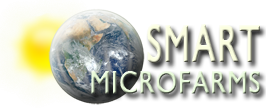
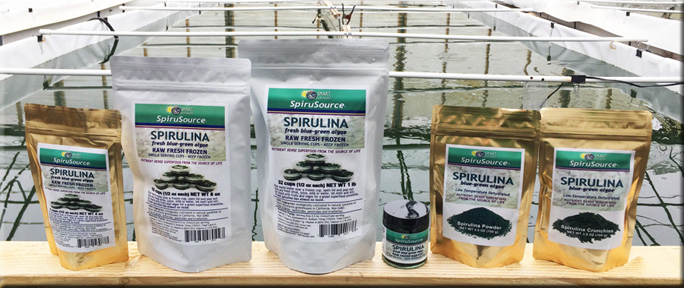
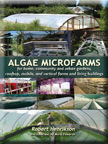
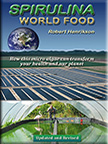 SPIRULINA
SPIRULINA